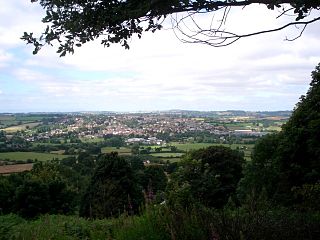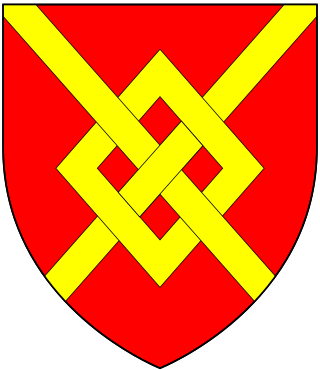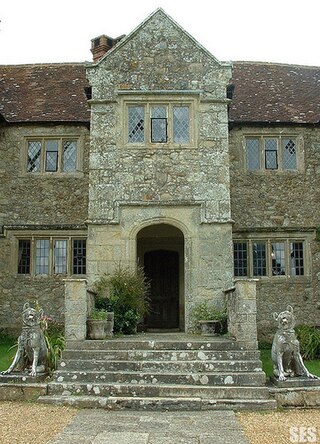
Bromyard is a town in the parish of Bromyard and Winslow, in Herefordshire, England, in the valley of the River Frome. It is near the county border with Worcestershire on the A44 between Leominster and Worcester. Bromyard has a number of traditional half-timbered buildings, including some of the pubs; the parish church is Norman. For centuries, there was a livestock market in the town.

The legacy of a family's passion for Victorian art and design, Wightwick Manor is a Victorian manor house located on Wightwick Bank, Wolverhampton, West Midlands, England. Owned by the National Trust since 1937, the Manor and its grounds are open to the public. It is one of only a few surviving examples of a house built and furnished under the influence of the Aesthetic movement and Arts and Crafts movement. The house is in a grand version of the half-timbered vernacular style, of which the most famous original example is Little Moreton Hall over 40 miles to the north, in Cheshire.

Much Marcle is a village and civil parish in Herefordshire, England, located 7 miles (11 km) north-east of Ross-on-Wye. The 2011 Census recorded the parish's population as 660. The name Marcle comes from the Anglo-Saxon word for a boundary field, mearc-leah. Much, in this case, means large or great, from the Middle English usage of the word.

Audley End House is a largely early 17th-century country house outside Saffron Walden, Essex, England. It is a prodigy house, known as one of the finest Jacobean houses in England.

Avebury Manor & Garden is a National Trust property consisting of a Grade I listed early-16th-century manor house and its surrounding garden. It is in Avebury, near Marlborough, Wiltshire, England, in the centre of the village next to St James's Church and close to the Avebury neolithic henge monument.

Aylton is a village in eastern Herefordshire, England. It is 5.5 km (3.4 mi) west of Ledbury. The population of this parish at the 2011 Census was 144. Aylton has a church and shares parish boundaries with Pixley, Putley and Little Marcle.

Southside House is a historical 15,650 sq ft (1,454 m2) home located on the south side of Wimbledon Common. It is Grade II* listed.

Hugh de Audley, 1st Earl of Gloucester, 1st Baron Audley of Stratton Audley in Oxfordshire, and of Gratton in Staffordshire, served as Sheriff of Rutland and was the English Ambassador to France in 1341. He was buried in Tonbridge Priory.
Major Malcolm Grane Ludovic Martin Munthe MC was a British soldier, writer, and curator, and son of the Swedish doctor and writer Axel Munthe and his English second wife Hilda Pennington-Mellor.

Lytes Cary is a manor house with associated chapel and gardens near Charlton Mackrell and Somerton in Somerset, England. The property, owned by the National Trust, has parts dating to the 14th century, with other sections dating to the 15th, 16th, 18th, and 20th centuries. "Yet all parts blend to perfection with one another and with the gentle sunny landscape that surrounds them," comments Nikolaus Pevsner. The House is listed as Grade I by English Heritage.

The Stanley family is an English family with many notable members, including the Earls of Derby and the Barons Audley who descended from the early holders of Audley and Stanley, Staffordshire. The two branches of the Audley family were made Barons Audley but both ended in the male line in the 14th century, after which their considerable estates were passed to a number of female heiresses, while the Stanleys would be elevated in the 15th century first to Barons Stanley and then Earls of Derby, a title they continue to hold.
This is a list of Sheriffs and, since 1998, High Sheriffs of Herefordshire

Stratton Audley is a village and civil parish about 2.5 miles (4 km) northeast of Bicester in Oxfordshire, England.

Lady Helena Emily Gleichen OBE DStJ was a British painter of landscapes, flowers, and animals, with a particular passion for horses. During World War I, she served as an ambulance driver and radiographer in France and Italy, where she was given the rank of major in the army. Her awards for her services included the Order of the British Empire.

Carswell Manor is a Jacobean country house at Carswell in the civil parish of Buckland in the English county of Oxfordshire. It is just north of the A420 road between Swindon and Oxford.

Arreton Manor is a manor house in Arreton, Isle of Wight, England. Its history is traced to 872 AD to the time of King Alfred the Great and his parents. It was left by King Alfred by his will to his youngest son Aethelweard. Once owned by William the Conqueror, as mentioned in the Domesday Book in 1086, in the 12th century it became part of Quarr Abbey and was used by the monks for over 400 years. In 1525, it was leased to the Leigh family. The manor was rebuilt between 1595 and 1612. Built in Jacobean style, it is in the shape of a "H".

The Great Budbridge Manor is a manor house just south of Merstone, near Arreton, Isle of Wight, England. Fish ponds on the grounds appear medieval.
Landguard Manor is a manor house in Shanklin on the Isle of Wight, England. Mentioned in the Domesday Book, over the centuries it was home to numerous notable gentlemen. It is a Grade II listed building. One of the finest known portraits by Sir Thomas Lawrence, English portrait painter and president of the Royal Academy, is located in its drawing room.

Pendley Manor is a hotel, conference and function centre near Tring, Hertfordshire, UK. It is a historic country house and is Grade II listed as an important example of Victorian architecture.

The feudal barony of Bampton was one of eight feudal baronies in Devonshire which existed during the mediaeval era, and had its caput at Bampton Castle within the manor of Bampton.



















